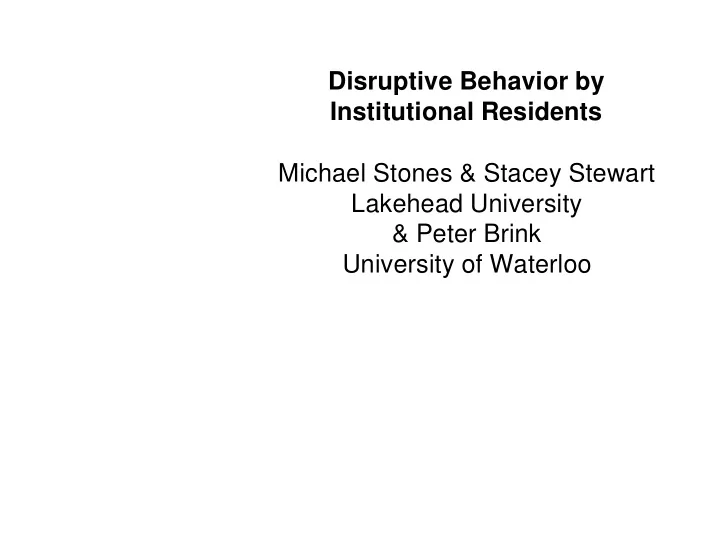

Disruptive Behavior by Institutional Residents Michael Stones & Stacey Stewart Lakehead University & Peter Brink University of Waterloo
Abuse and neglect in long-term care is bidirectional. Stones, Stewart, and Kirkpatrick (2003) found that 50% of residents engaged in disruptive behavior that included the abuse of staff and other residents. Souder & O’Sullivan (2003) found that staff spend considerable time on the management of disruptive behavior, which detracts from the time available to provide inclusive care. Abusive behavior by residents may also trigger retaliatory behavior by staff. Pillemer and Moore (1989) found that 10% of staff admitted to physical abuse and 40% to psychological abuse of residents.
Far from being caused by chronic progressive illness, earlier reports by the present team and others showed that disruptive behavior by institution residents relate more strongly to acute conditions of discomfort or distress. Residents with delirium, untreated depression, dental pain, and wetness because of incontinence are likely to behave disruptively. Institutions may have neither the staff time nor expertise to identify properly the antecedents of disruptive behavior. Instead, the institutional response is typically to pacify the symptoms rather than attempt to diagnose the cause. Pacification includes the overuse of antipsychotics and physical restraint beyond levels necessary to manage psychiatric disorder or to ensure safety. Bronskill et al. (1994) showed that 24% of admissions to nursing homes received neuroleptics within 1-year, and CIHI (1998) reported higher restraint use in Canada than in other countries.
This research used data kindly supplied to Stacey Stewart by the Canadian Institute on Health Information as part of their Graduate Student Data Access Program. The data were just over 17,000 Minimum Data Set (MDS 2.0) assessments in 2002 of residents of complex continuing care facilities in Ontario. The subsample analyzed were non- comatose persons over 18 years, which comprised 43% males and 57% females with a mean age of 75 years (sd=13.4). Because the findings to be reported with these data replicate those from nursing homes in Thunder Bay (Brink, Stewart & Stones, 2004), it is probably fair to assume generality across sectors within long-term care.
The purpose was to examine the excess use of antipsychotic medication and physical restraint (i.e., trunk, limb, chair to prevent rising, but not bedrails) beyond levels predicted for the management of psychiatric disorder or ensure safety. The first findings compare assessments within 14-days of admission to those obtained after prolonged residence (usually 1-year).
Daily antipsychotic, antidepressant, and restraint use are higher in the later assessments. Psychotropic Medication & Restraint in 17,000 Complex Continuing Care Assessments 30 Percentage with Treatment 27 26 24 22 Treatment 20 20 19 daily antipsychotic daily antianxiety 14 daily antidepressive 12 Daily Restraint 10 New admission Later assessment Reason for assessment
Diagnosis of dementia is higher in the later assessments, but the only difference in psychiatric diagnosis relates to depression. Percent with Mental Dysfunction Diagnoses in 17,000 Complex Continuing Care Assessments 40 Percent with Diagnosis 30 31 Diagnosis 20 21 20 Dementia 14 Depression 10 Anxiety 5 4 Schizophrenia 0 New admission Later assessment Reason for assessment
Falls are less frequent in the later assessments. Percent with Falls in Past 3 Months in 17,000 Complex Continuing Care Assessments 40 Percent that Fell in last 3 months 36 30 20 10 11 0 New admission Later assessment Reason for assessment
There was not much difference in cognitive measures between the two assessment periods but physical function was inferior at the later Assessment. Scale Means for Cognition & ADL in 17,000 Complex Continuing Care Assessments 16 14 Mean Score on Scale 12 10 8 Scale 6 Cognitive Disorder 4 Delirium 2 Physical Function (ADL) 0 New admission Later assessment Reason for assessment
Disruptive behavior is more frequent in the later assessments. Disruptive behavior was measured by an 8-item scale with an internal consistency >.8. The component behaviors include physical and verbal abuse, socially inappropriate behavior, and resisting care. Percent with Disruptive Behavior in 17,000 Complex Continuing Care Assessments 50 Percent with any Disruptive Behavior 42 40 30 24 20 New admission Later assessment Reason for assessment
Analyses to predict the daily use of antipsychotic medication and restraint, respectively, used logistic regression against the disruptive behavior scale with control of psychiatric diagnosis (i.e., any psychiatric diagnosis, symptoms of depression/anxiety), diagnosis of dementia, cognition (i.e., cognitive impairment scale, delirium index), and physical dysfunction (i.e., activities of daily living, falls in the preceding 90 days). The findings for the admission assessments, later assessment, and all assessments showed the disruptive behavior scale to be among the strongest predictors with odds ratios >6:1 for the higher levels of disruptive behavior in some analyses.
The figure below shows this trend over all the assessments. At the lowest level of disruptive behavior the frequencies of treatment are <15%. At the highest level of disruptive behavior, the frequencies are >50%. Percent with Treatment in 17,000 Complex Continuing Care Assessments 70 60 Percent with Treatment 50 40 30 Treatment 20 Daily 10 Antipsychotic 0 Daily restraint Low 1.00 2.00 3.00 High Disruptive behavior categories
CONCLUSIONS The strengths of the study include the large data array based on reliable measures. The limitations include the cross-sectional design. The findings replicate those from nursing homes by showing that disruptive behavior accounts for substantial use of antipsychotic medication and physical restraint after control of other relevant diagnoses, capabilities, and risks to well-being and safety. This trend appears to reflect pacification. Because several previous reports suggest that the main causes of disruptive behavior are discomfort and distress, and that disruptive behavior detracts considerably from the time available to staff to provide good care, we strongly recommend that proper and effective intervention for disruptive behavior becomes a priority issue for the long-term care sector.
Recommend
More recommend